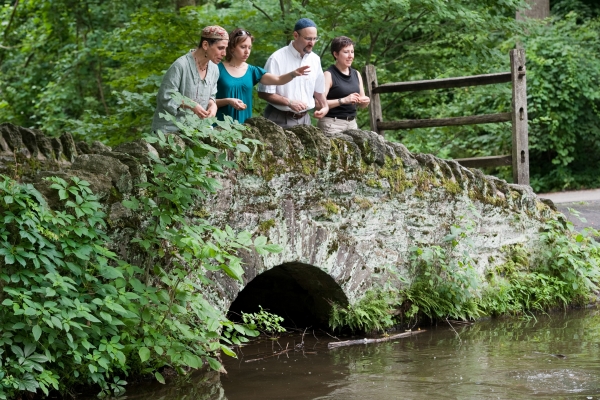Tashlikh, meaning “cast away,” is a ritual performed on Rosh Hashanah (or during the 10 days between Rosh Hashanah and Yom Kippur) as a physical reminder of the human effort to cast away one’s sins. By casting crumbs of bread into the water and reciting the verse from Micah—”cast all our sins into the ocean’s depths”—we state our intention to return to our true selves. For many Jews, Rosh Hashanah is a time for reciting many words. Through tashlikh, we use our bodies and actions to do the work of return. Although the rabbinic authorities originally objected to this ritual, Jews stubbornly performed it until it became a “traditional” part of the holiday.
Tashlikh can be a time for women to gather in a safe environment, consider their lives together, and examine the ways of their community. How have we grown as individuals and as women? How have we fallen short? How have the larger Jewish and secular communities supported us? How have they failed us? This ceremony, designed by the Ma’yan staff, gives women a place to be open about the truths of their lives and to share deeply with one another.
Tashlikh should be performed near a body of water so that the ritual of casting away can be performed. If you have no body of water, use a large bowl or bucket.
Opening Song or Niggun (Wordless Song)
Set the tone for the ritual in the first few moments. If your ritual occurs on a weekday evening, begin with song to slowly transition people out of the workday and the busy-ness of the workweek into a quiet and contemplative space. Find a song leader—someone who can teach new pieces and encourage participants to join in. Make sure to provide a song sheet with all of the words and liturgy that you will be using throughout the ritual (with English translations and transliteration of the Hebrew). Possible songs include Hannah Senesh’s Eli, Eli; Min Hameitzar, “Return Again,” and many niggunim.
Introduction to the Ritual of Tashlikh
Once you have established the tone, begin the ritual with some background or a small teaching about tashlikh. You might want to include the following:
-
Some historical background about tashlikh (see Seasons of our Joy or other holiday guide)
-
An explanation of the Hebrew word: tashlikh meaning “to cast off,” also related to shalekhet, the word that describes a tree that sheds its leaves
-
A short discussion about teshuvah (return) and the contemplative and introspective time that tradition gives us during the month of Elul
After some introductory words, give participants a brief overview of what you have planned for the evening. If the group is small enough, you may want to have everyone introduce themselves either using their matrilineage (name, bat/daughter of mother’s name, bat/daughter of grandmother’s name, etc.). Or you can have everyone answer an opening question related to teshuvah (return/repentance), tashlikh, or Elul, such as, “What does the word teshuvah, turning, mean to you?” or “How have you spent this month of preparation for the High Holidays?”
Meditation
Before participants enter into their individual casting, provide a space for them to reflect on the past year and focus on both things that they are ready to cast off and things that they will hold on to. For those participants who have not already begun this internal work during the month of Elul, this section of the program will offer a meaningful way of preparing both for the ritual and for the High Holidays.
Partner Sharing
Have the group break up into pairs and share something about the past year. One idea might be to ask each pair of participants to share with one another something about themselves which they would like to cast away in the coming year, as well as something they would like to keep. Another idea might be to ask what changes each partner in the pair plans to make in the coming year and what holds them back from making those changes.
Individual Casting (personal lives)
Give individuals time to cast their bread into the body of water. Lead a niggun during this time and allow people to spend a moment thinking, meditating, or praying as they perform the ritual. You can provide bread, bread crumbs, or rose petals (see “Ideas for Casting,” below) for this piece of the program. You can choose to have participants cast in silence or have the song leader play a niggun or instrumental piece in the background. Allow a fair amount of time for this section. Afterward, begin to gather participants back into the main circle with singing and/or dancing that starts slowly and builds the energy of the group.
You might want to think about supplying participants with a poem or piece of liturgy to say at the water if they choose. Explain before people break into pairs that these readings for individual casting can be found on the song sheet, and if necessary (if they are in Hebrew or if they are sung), go over them as a group.
Hatarat Nedarim Ceremony
(Annulment of Vows–insert this ceremony here if desired, or use it in place of the individual casting)
Materials:
-
water-soluble pens
-
paper
-
challah
-
torch candles
-
heavy duty paper
-
shofar
Order:
-
Niggun (use Hashiveinu or other High Holiday niggun)
-
Kol Nidre is a community Hatarat Nedarim, an annulment of vows, to release us from vows to God that we are unable to fulfill. Since the time of the Bible, Jews have had the concept of an oath or neder, a binding statement of what one has committed to do. There is a ceremony to release one from such a vow, called Hatarat Nedarim. This is the concept this segment of the ritual will explore.
-
Put people in groups of four so that everyone has a beit din (court of three).
-
Have each person brainstorm list of all her “shoulds” and “have tos,” everything she is committed to.
-
Have each person choose two words that represent things from her list she wants to get rid of and things she feels good about that she chooses to do with her free will and write each on an index card. Have each person put one in each hand (or pocket).
-
As people go down to the water, encourage them to focus on balance and release.
-
Down at the water, people get into their groups of four. One person in each group is given a bottle of water. The person whose card is being washed says whatever they want about the word on the card and gives it over to be held and poured on. Repeat four times. When everyone in the group is done join the big circle and sing the niggun again.
-
In the big group people will bring their “keep cards” and put them in the middle face up and take a challah roll from the middle. When everyone has done this, make a blessing together over the challah and honey. Say: “May it be that by honoring our will we honor Your will.”
Closing the Ritual
Combine any or all of the following elements for your closing ritual
-
Shofar blowing
-
Closing song
-
Going around the circle and answering a question about the meaning of tashlikh for each individual
-
Reading a poem, blessing, or other reading (Marge Piercy’s poem, “Coming Up On September,” found on p. 291 of the Reconstructionist makhzor Kol haNeshamah, is a good choice)
-
Taking turns stating personal commitments for the coming year to take action around women’s and girls’ rights and resources, women’s advancement, etc.
Apples and Honey
Bring apples and honey and invite everyone to share in the sweetness of the new year.
Additional Possibilities: Guided Meditation for Tashlikh
The meditation by Erika Katske can be read slowly, out loud to the group as a way of helping participants recall particular moments they experienced in the past year. Click here for Erika’s Guided Meditation.
Additional Possibilities: Pair Activity
Tradition teaches that tashlikh is a cyclical ritual—when we throw the bread that we use for tashlikh into the water, it is eaten by fish and recycled back into the food chain. Also, the Hebrew word shalekhet, related to tashlikh, refers to a tree that loses its leaves in the fall. These leaves fertilize the soil around the tree, helping new plants and trees to sprout in the spring. In other words, that which is no longer useful, that which we shed or cast off, can become sustenance to something else. This idea is the basis for the following activity that even among human beings, what we cast off might be exactly what another within our community is looking to bring into her life. Allow participants to begin the High Holiday cycle by both giving and receiving aspects of the past year symbolically through exchanging index cards.
You will need:
-
Index cards (enough for each participant to have as many as 5)
-
Pens (enough for each participant)
-
Ribbon or string (hung horizontally between two trees)
-
Paper clips
Hang the string or ribbon horizontally between two trees at the site of your tashlikh ritual. While participants are talking to each other (after giving them some time to discuss) pass out about 10 index cards and 2 pens to each pair. Tell participants to record one thing on each index card—either one thing for the previous year that they will cast off in the coming year, or one accomplishment from the previous year of which they are proud. They can write on as many cards as they wish, but should only write one thing on each card.
Before the group moves from pairs into individual casting, have participants hang their cards (with paper clips or safety pins) to the ribbon/string on their way to the water. You should end up with a “clothesline” full of index cards that contain each individual’s tashlikh reflections. The string/ribbon should hang freely in the background as you conduct the remainder of the program.
At the close of the program, explain the ways in which tashlikh is a cyclical ritual (see above). Then, invite each participant to take one card from the ribbon—a card that is not their own—something from someone else that they want to incorporate into their life in the coming year. In this way, participants will symbolically recycle each other’s accomplishments and “sheddings.”
Additional Possibilities: Ceremony for Casting Out Sins Against Women
You will need:
-
A large bowl filled with water (preferably glass or plastic so that it’s see-through)
-
A few sheets of non-porous paper (parchment, vellum, semi-glossy, etc.)
-
Red water-based ink pens
-
Something to write on (clipboard, book, etc.)
Note: you may want to test out your supplies before the ritual!
A group casting will allow you to incorporate the idea of communal responsibility into your program. Begin by explaining to participants that the majority of the High Holiday liturgy is in the plural and therefore reminds us that we bear responsibility for the wrongdoings of our community and for the wrongdoings of individuals within our community. In one sense, this is an enormous responsibility to bear—most people have their hands full with their own personal teshuvah (repentance)! In another way, this idea of communal responsibility allows us to name and then cast off the wrongdoings of our community. In the context of a women’s tashlikh ritual, this idea can become a very powerful moment for women to name and cast off the sexism that they have experienced or witnessed in the Jewish community.
After you have given them some background, ask participants to call out the ways in which our community has wronged women. Have two or three people record the responses on the pieces of non-porous paper with the red pens. When the group has finished naming the things it would like to cast, begin a song or niggun, tear off each wrongdoing so that it is on its own piece of paper and pass the pieces out to participants. When all of the statements have been distributed, continue singing and have each woman place her piece of paper into the bowl of water. Mix the bowl occasionally, asking participants to observe the ink, and thus the communal wrongdoing, being washed away from the paper.
Note: you can also simply cast more bread (NOT PAPER) into the water as a group for this piece. Make sure that all involved will be able to see and hear what’s happening if you decide to do this instead.
Additional Possibilities: Ideas for Casting
It is possible to throw rose petals instead of bread or in addition to bread. It’s something organic that won’t disturb the ecosystem. This emphasizes the natural process of tashlikh. We are like trees shedding our leaves in the fall. We are getting rid of what is no longer useful to us like deciduous trees—not necessarily throwing into the water bad things we’ve done, but instead, like trees, shaking free of what has dried up and is no longer healthy or useful to us.
It is also possible to have bread for throwing and bread for eating, so that we can acknowledge both what we want to let go of and what we want to hold on to, what we need to ingest.












